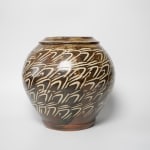Shimaoka Tatsuzo 島岡達三 1919-2007
Large Jar with Inlay 地釉象嵌印文壺, 1960
Stoneware
H12.5" x Dia13"
H31.7 x Dia33.0 cm
H31.7 x Dia33.0 cm
With Signed Wood Box
Sold
Further images
-
(View a larger image of thumbnail 1
)

-
(View a larger image of thumbnail 2
)

-
(View a larger image of thumbnail 3
)

-
(View a larger image of thumbnail 4
)

-
(View a larger image of thumbnail 5
)

-
(View a larger image of thumbnail 6
)

-
(View a larger image of thumbnail 7
)

-
(View a larger image of thumbnail 8
)

-
(View a larger image of thumbnail 9
)

-
(View a larger image of thumbnail 10
)

-
(View a larger image of thumbnail 11
)

-
(View a larger image of thumbnail 12
)

-
(View a larger image of thumbnail 13
)

-
(View a larger image of thumbnail 14
)

Based in Mashiko, Shimaoka Tatsuzo was designated a Living National Treasurein 1996. His designation was for folk craft, particularly his rope-impressed inlaywares (mingei jomon zogan). Shimaoka was a highly skilled...
Based in Mashiko, Shimaoka Tatsuzo was designated a Living National Treasurein 1996. His designation was for folk craft, particularly his rope-impressed inlaywares (mingei jomon zogan). Shimaoka was a highly skilled potter who masteredand combined a number of techniques. His father made braided silk cords for aliving. This familial lineage, combined with his later exposure to rope-impressedJomon period (c.6000 – 300 BCE) earthen wares, enabled him to develop hissignature style. His rope impressed surfaces were unique: he added the Koreanmishima ware style inlay that he was introduced to by his teacher Hamada Shoji,as Korean ceramics were influential in the mingei movement during the 1920s to30s. Finally, his encounter with German salt glazed wares led him to develop a
body of work using that technique as well.
body of work using that technique as well.













